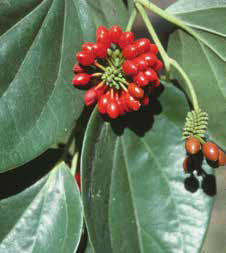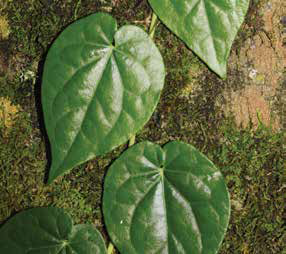The native Pepper Vine (Piper hederaceum var. hederaceum) grows in the rainforests of eastern Australia from the south coast of NSW to North Queensland and is relatively common in Southeast Queensland (SEQ). It belongs to a large genus of shrubs and vines, with an impressive 2000 odd species occurring in the warmer areas of the globe. In Australia there are seven species in the Piper genus with just the one found in SEQ.
The leaves of Pepper Vine were used by some Aboriginal people for the treatment of sore gums. Further a field, numerous Piper species are widely used for culinary, medical and intoxication purposes. These include the Malaysian Black Pepper (Piper nigrum) that graces most kitchens. Piper methysticum, commonly known as Kava is used in Polynesia as an intoxicant while numerous Asian species, such as P. betle are chewed together with betel nuts. In Southeast Asian countries such as Thailand numerous species are used in cooking. The fruits of our Pepper Vine are said to have a taste similar to Brazilian Cherry, while the seeds when ground are an acceptable pepper substitute (Cribb, 1975).
This attractive vine climbs tree trunks using its adventitious root system which grasp onto the bark at intervals along the vines stem. The fleshy, palmate veined leaves can form large, dense curtains of foliage. The leaves are heart shaped and up to 10 cm long, however they are usually smaller on fruiting branches. Female flowers are followed by bright-red ovoid berries about 5 mm long on stalks 1-2 cm long.
It is these clusters of bright red fruits in the rainforest canopy that fruit-eating (frugivorous) birds are attracted to. Over the years a number of observant Land for Wildlife landholders have relayed stories to me of how they have seen multiple Rose- crowned Fruit Doves feeding together on the fruits of Pepper Vine. Getting a good view of a Rose-crowned Fruit Dove is a special birding moment, so to see half a dozen feeding at once, and at close quarters, is an image that stays with you forever.
Recent research by Hawkins (2014) on the feeding habitats of Topknot Pigeons in the rainforests on the mid-north coast of NSW found that Pepper Vine fulfills an important ecological niche in subtropical rainforests. In the warmer months of the year a single vine can bare large volumes (up to 10 kg) of their spicy fruits, which are an important food source for pigeons, fruit doves, bowerbirds and other frugivorous birds.
Topknot Pigeons (not to be confused with the common Crested Pigeons) are a large fruit-eating specialist of rainforests. Accounts from early pioneers relay stories of flocks consisting of thousands of birds flying overhead. Today you rarely see flocks larger than 100 birds, and more often in flocks of about a dozen. Hawkins reports observing 15-40 topknots feeding on Pepper Vine at one time. Precious few other seed dispersers travel in such numbers and are so mobile in the landscape. Collectively, Topknot Pigeons have the capacity to move large quantities of seeds between their feeding and roosting sites. This seed dispersal is considered to be a crucial ecosystem process in facilitating natural regeneration of rainforests.
Pepper Vines fruit over the summer months and do so annually. Compared to many fruit-bearing rainforest trees, Pepper Vines provide a consistent and reliable summer food source. Attracting large numbers of frugivorous birds to your patch is likely to result in some seed input from adjoining patches of forest where the birds have been foraging.
While many rainforest revegetation efforts include a range of tree species that produce fleshy fruits it is not often that you see vines included in the planting palate. Indeed some native vines can be temporarily undesirable (Cissus spp.) in the establishment stages of revegetation due to their vigorous growth and smothering habits. Pepper Vine however is not so vigorous, and it can be introduced once trees are over head height and are providing sufficient shade and climbing opportunities. Pepper Vines can also be planted on protected edges such as the southern side of a rainforest patch.
References
Hawkins BA (2014) Birds, fruit and nectar: spatio-temporal patterns of regional bird abundance and food availability in subtropical eastern Australia. Monash University Doctorate Thesis.
Hawkins BA. The Year of the Topknot. Australian Birdlife Vol. 3 No. 2, June 2014.
Lassak, EV & McCarthy T (2011) Australian Medical Plants. New Holland Publishers.
Cribb AB & JW (1975) Wild Food in Australia. William Collins Publishers.
Jones DL & Gray B (1977) Australian Climbing Plants. Reed Books.
Article by Nick Clancy Land for Wildlife Officer Sunshine Coast Council. All photos by Glenn Leiper.


